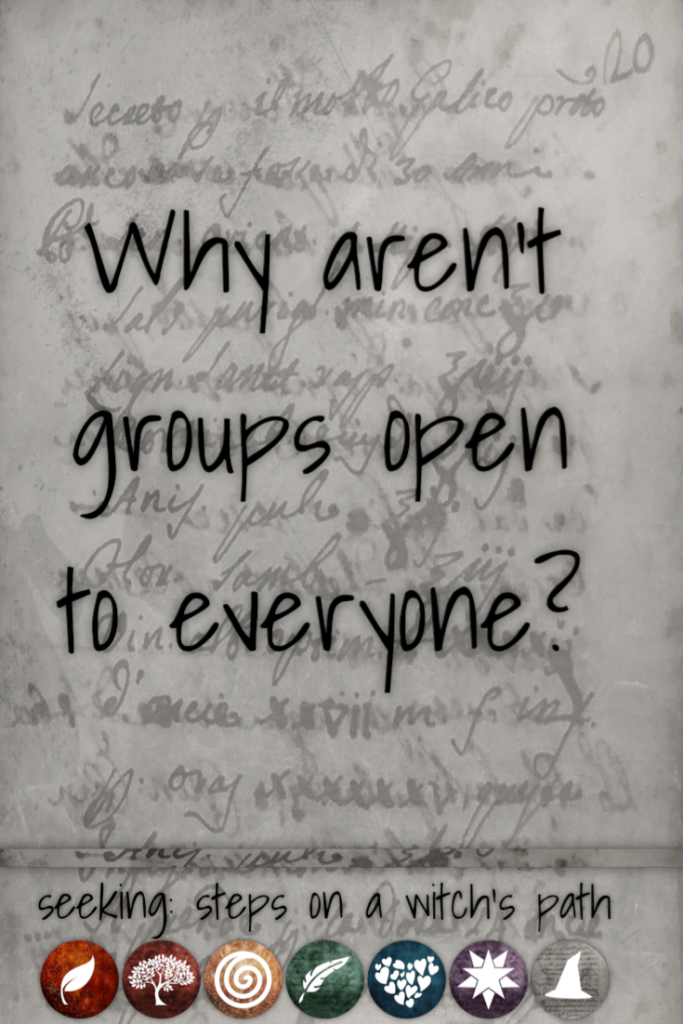The somewhat flippant answer to this – while still very accurate – is that living rooms hold only so many people.
See, most Pagan groups – and especially most religious witchcraft groups – are intentionally fairly small, because much of the way they work works best with a small number of people who can build up trust and connection with each other.
(There are larger open ritual groups, but these are generally focused either on a pretty specific goal, with some filtering, or they’re open to anyone, but focused on general celebrations and community.)
Most religious witchcraft groups do run smaller for a variety of reasons. Let’s talk about them.

1) Only so many people fit
I come back to this one first because really, it’s very practical. When a small group is meeting in personal space, you only get so far before it starts getting unwieldy. (And, of course, with a small group, it doesn’t make a lot of sense to either maintain a larger separate building, or sometimes even to rent one.)
For group work, the people hosting are going to want:
- Enough parking for people who drive without annoying the neighbors.
- Enough seating for everyone (chances are, most groups will have a couple of people who really need chairs, for various reasons, maybe a few people who prefer sitting on the floor, and some people who can do either.)
- Enough clear space for ritual – it’s a lot easier to clear a space the size of a smallish dining room than it is to clear a space that will hold 20 comfortably. Moving furniture back to the walls of the living room only gets you so far.
For all sorts of reasons, this means that 10-15 people is about the upward size limit for working in someone’s home.
2) Personal connections matter
Religious witchcraft work, in particular, tends to rely heavily on personal connections between participants in a group.
You probably know that the traditional size for a coven is 13 – but it turns out there’s a good psychological reason for this: that’s about the upper limit of how many individual connections we can maintain in the same social context. More than that, and groups tend to start fragmenting into smaller subgroups.
3) A clear, focused, group mind.
One of the things behind the theory of coven work is that a group of people with a shared intention and focus can be exponentially more effective than individuals working on their own. However, you’ve got keep people focused in the same direction – which has some size limits due to the practical and psychological factors noted above.
4) Not everyone fits with a group
It doesn’t mean that the people who don’t aren’t good people – or competent witches, or whatever else you want to talk about. They’re just not a good fit for that particular group right now.
This is something we really should be used to. Good managers at jobs look to hire people who will make a well-rounded set of skills in that group of employees. Coaches of sports teams look for people who complement each other’s skills.
Covens and small religious groups work the same way: you want people who have enough in common that working together makes sense, but who bring enough different things that there’s variety and flexibility and different options available.
5) Adding people is time-consuming
First, you have to spend a fair bit of time getting to know each other, to even figure out if you’ve got a possible good fit. In my group, this takes 3-6 meetings, and usually about 15 hours of time (including the initial email stages) on both sides.
But after that, there’s still the time and energy to get someone up to speed in the group. Most religious witchcraft traditions cover a chunk of material to get someone to a point where they’re solid in the basics of their particular practice – usually something that takes 5-8 hours a month (at least) of dedicated teaching time in some form. Obviously, groups are sometimes going to be better able to do that at some points than at others.
6) Groups go through cycles.
A given group might be up for taking in several prospective new members one year. The next year, they might hit their practical limit for numbers. Or maybe the people who normally teach have some health challenges, or some high demands at work, or something else that means they don’t have quite as much time or energy to spare to teach a new member of the group or see how they fit in. Since we’re talking small groups, lead by volunteers who host and teach because they think it’s important, these things can cause some significant pauses for good reason.
The good news is that often those things shift again in a year or two. More advanced students of the tradition may get to a point where they can form a new group. Health or job issues can shift back and allow more time for the group. They may figure out some way to spread out the workload that’s more sustainable.
What does it all mean?
Most simply, it means that lots of people – no matter how nice or great or wonderful they are – won’t be a great fit with every group. But it also means that the groups they might be a fit with might go through periods when, for whatever reason, they’re not taking in new students or new members.
If eventual group work is important to you, patience helps a lot, as well as finding ways to continue to learn and grow that make group work more accessible later.

Last updated December 26, 2016. Reformatted November 2020.



